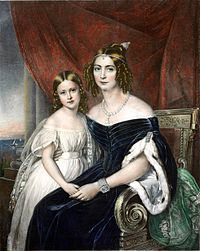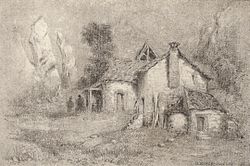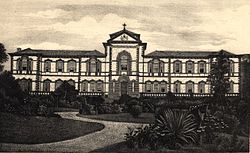- Princess Maria Amélia of Brazil
-
Princess Maria Amélia 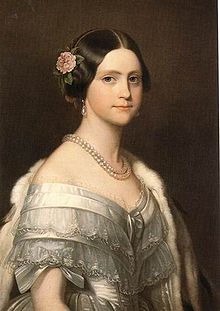
Dona Maria Amélia, Princess of Brazil around age 17, c. 1849 Full name Maria Amélia Augusta Eugênia Josefina Luísa Teodolinda Elói Francisco Xavier de Paula Gabriela Rafaela Gonzaga House House of Braganza Father Pedro I of Brazil Mother Amélie of Leuchtenberg Born 1 December 1831
Paris, FranceDied 4 February 1853 (aged 21)
Funchal, PortugalBurial Convento de Santo Antônio (Convent of Saint Anthony), Rio de Janeiro Signature 
Religion Roman Catholicism Dona Maria Amélia (1 December 1831 – 4 February 1853) was a princess of the Empire of Brazil and a member of the Brazilian branch of the House of Braganza. Her parents were Emperor Dom Pedro I, the first ruler of Brazil and Amélie of Leuchtenberg. The only child of her father's second marriage, Maria Amélia was born in France after Pedro I abdicated the Brazilian throne in favor of his son Pedro II. Before Maria Amélia was a month old, Pedro I went to Portugal to restore the crown of the eldest daughter of his first marriage, Maria II. He fought a successful war against his brother Miguel, who had usurped Maria II's throne.
Only a few months after his victory over Miguel, Pedro I died from tuberculosis. Amélie of Leuchtenberg brought Maria Amélia to Portugal, where she remained for the rest of her life, never traveling to Brazil in her lifetime. The Brazilian government refused to recognize Maria Amélia as a member of Brazil's Imperial House because she was foreign-born. However, her elder half-brother Emperor Pedro II was declared of age in 1840 and intervened on her behalf.
In early 1852, Maria Amélia was engaged to Archduke Maximilian of Austria, but she died before the marriage could take place. Maria Amélia contracted tuberculosis and was taken to the town of Funchal on the Portuguese island of Madeira because of the island's reputedly healthy climate. Her health continued to deteriorate, however, and she died on 4 February 1853. Her body was brought to mainland Portugal and interred in the Braganza Pantheon. Almost 130 years later, Maria Amélia's remains were carried to Brazil. In Maria Amélia's honor, her mother financed the construction of a hospital in Funchal called "Princesa D. Maria Amélia". Her fiancée Maximilian made a personal pilgrimage to Brazil and other places linked to her and his journey is believed to have influenced his eventual acceptance of the throne of Mexico in 1864.
Contents
Early years
Birth
Maria Amélia was born on 1 December 1831 in Paris, France[1][2] and christened Maria Amélia Augusta Eugênia Josefina Luísa Teodolinda Elói Francisco Xavier de Paula Gabriela Rafaela Gonzaga.[3][4] She was the only daughter of Dom Pedro, the Duke of Braganza, and his second wife Amélie of Leuchtenberg. Through her father, Maria Amélia was a member of the Brazilian branch of the House of Braganza (Portuguese: Bragança), and was referred to by the honorific Dona[A] from birth.[5] She was the granddaughter of the Portuguese King João VI.[B] Maria Amélia's mother was the daughter of Eugène de Beauharnais, Duke of Leuchtenberg and the stepson of Emperor Napoleon Bonaparte of France. Eugène was married to Princess Augusta, eldest daughter of King Maximilian I of Bavaria.[1]
Pedro had formerly been the first Emperor of Brazil, as Pedro I, and also King of Portugal, as Pedro IV. He was succeeded on the Portuguese throne by his eldest daughter, Maria II, Maria Amélia's elder half-sister. The young Queen was the child of Pedro's first marriage to Archduchess Maria Leopoldina of Austria. In 1828, Maria II's crown was usurped by her uncle (Pedro's younger brother) Dom Miguel I.[6] Eager to restore his daughter back to her throne, Pedro abdicated the Brazilian crown in April 1831 and departed for Europe with Amélie, who was pregnant with Maria Amélia.[7]
To acknowledge Maria Amélia's rights as a Brazilian princess, Pedro invited several guests to observe her birth. Among these was José Joaquim da Rocha, one of the leading figures during Brazil's independence, who was then serving as the Brazilian diplomatic envoy to France.[4] The newborn's godparents were the French King Louis Philippe I and his consort, Maria Amalia of Naples and Sicily.[8] Pedro sent a letter to his children who had remained in Brazil—including his son, child-emperor Dom Pedro II—with the message: "Divine Providence wanted to lessen the sorrow that my paternal heart feels in the separation from Y.I.M. [Your Imperial Majesty], giving me one more Daughter, and to Y.I.M., one more sister and subject ...".[8]
Brazilian princess
When Maria Amélia was only 20 days old, her father departed England[dubious ] to invade Portugal after he secured French and British military aid.[9][10] For almost two years, she lived in Paris with her mother and half-sister Maria II.[11] When news arrived that the Portuguese capital, Lisbon, had fallen to Pedro's forces, Amélie of Leuchtenberg left Paris with her infant daughter and stepdaughter for Portugal. They arrived in Lisbon on 22 September 1833 and disembarked the next day.[12] Charles John Napier, a British naval officer who had fought alongside Pedro, wrote about the emotional reunion: "I never saw [Pedro] so happy and pleased; he went onboard just a little above Belém; he was received at the ladder by the empress [Amélie] who hugged and kissed him with the greatest affection: the queen [Maria II] was very moved and could not hold her tears. The little Princess [Maria] Amélia, his youngest daughter, took much of his attention: she became somewhat scared of seeing his bushy beard and did not correspond much to his caresses."[13]
With Miguel I defeated and exiled to Germany[14], and Maria II restored to the throne, Maria Amélia and her family remained in Portugal, first residing in the Palace of Ramalhão, and later in the Royal Palace of Queluz near Lisbon. However, the war had taken its toll on Pedro's health, and he was dying of tuberculosis.[15] Maria Amélia, who was not yet three years old, was taken during the early hours of 24 September 1834 to Pedro's deathbed. Very weak, Pedro raised his hands to bless her and said: "Always tell this child of the father who loved her so dearly ... not to forget me ... always to obey her mother ... those are my last wishes ..."[16] Pedro died in the early afternoon of the same day.[17]
The widowed Amélie would never remarry and her days were spent overseeing her daughter's upbringing in Portugal where they remained even though they were not members of the Portuguese Royal Family. Neither of them ever traveled to Brazil and Amélie unsuccessfully petitioned the Brazilian government to recognize her daughter as part of Brazil's Imperial Family, which would also entitle her to an income. Maria Amélia's half-brother Pedro II was a minor, and the government of Brazil was in the hands of a precarious regency. The government refused to acknowledge Maria Amélia as a Brazilian princess due to her foreign birth, and forbade both her and her mother from setting foot in Brazil.[18] The situation would only change after Pedro II was declared of age in 1840 and was in a position to insist that she be recognized as a member of his household. Aureliano Coutinho (later Viscount of Sepetiba)[C] and Minister of Foreign Affairs at the time, requested the Brazilian parliament to grant Maria Amélia recognition, which occurred on 5 July 1841.[19]
Later life
Ill-fated engagement
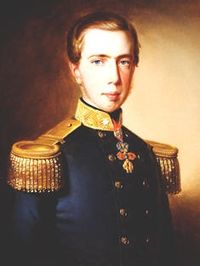 Archduke Maximilian around age 20, c. 1852. He became Emperor of Mexico in 1864, but was executed three years later.
Archduke Maximilian around age 20, c. 1852. He became Emperor of Mexico in 1864, but was executed three years later.
The blond[20][21] Maria Amélia grew into "a girl of striking beauty as well as cultivated intelligence", according to historian H. Montgomery Hyde.[22] She was described as very kind, religious[23] intelligent[24][25][21] and possessing shrewdness as well as a hot-headed and slightly ironic personality.[25] The princess received a refined education. She was highly skilled in drawing, painting and playing the piano[26] and loved poetry.[27] She spoke Portuguese, French and German fluently.[23] A teacher said of her that she "has, without knowing, an exceptional talent for dialectic, an ability that would make the fortune of a young law student."[28]
One of the main forces that apparently motivated Maria Amélia's dedication to her education was her father. The late Duke of Braganza cast a large shadow in her life, and was always remembered by his daughter, who would often ask the people around her: "and my father, who looks at me from heaven, shall he be pleased with his daughter?"[28] She was never quite able to cope with her father's death and it deeply touched her.[29] Maria Amélia remarked on her sad feelings after she saw a garden where Pedro I planted a sycamore: "A profound sadness invaded me when contemplating these trees that had survived my father and that, probably shall survive all of us. It is an image of human fragility. Man is the most frail of all beings; he dies, while the objects which were seemingly created for his use, endure the centuries! ... But I am digressing in my melancholic reflections ..."[29]
In early 1852, Austrian Archduke Maximilian, then serving in the Austrian navy and on a stopover in Portugal, visited Amélie and Maria Amélia.[30] The princess had already met him at a family reunion in Munich in 1838. Maximilian's mother was the younger half-sister of Maria Amélia's maternal grandmother, and both women were members of the German House of Wittelsbach.[31] The Archduke was also related to Maria Amélia's older half-siblings, as his father was the younger brother of Brazilian Empress Leopoldina.[32] They fell in love with each other and were betrothed,[30] however, the engagement was never made official due to Maria Amélia's early death.[30]
Premature death
In February 1852, Maria Amélia contracted scarlet fever.[33] As the months passed, she did not recover and was affected by a persistent cough—the onset of tuberculosis.[34][35] On 26 August, the princess departed from the Janelas Verdes palace, where she lived,[36][37] and traveled to the island of Madeira. The island's climate had a salutary reputation, as Maria Amélia noted: "the fevers disappear, they say, as if by magic!"[38]
Maria Amélia and her mother, who had accompanied her, disembarked on 31 August in Funchal, the capital of Madeira.[39] The entire town greeted her joyfully, and a crowd followed the princess to her new home.[40] She adored the island and told her mother: "If I one day recover my previous robust health, isn't that so mommy, we will stay a long time in this island. We will make long excursions in the mountains, we will find new paths, just as we did in Stein!"[41] But her health only worsened, and by the end of November, all hope was gone.[24] By the beginning of 1853, the princess was bedridden, and she knew death was approaching: "My strength diminishes from day to day; I can feel it ... we are reaching the beginning of the end."[42] A little after midnight in the early hours of 4 February, a priest administered the last rites. Maria Amélia tried to comfort her mother: "Do not cry ... let God's will be done; may He come to my aid in my last hour; may He console my poor mother!"[43] She died later that morning at around 4 a.m.[44]
The princess's body remained in a chapel next to the house where she died until it was taken back to the Portuguese mainland on 7 May 1853.[45] On 12 May, the coffin was disembarked at Lisbon, and a grandiose funeral followed.[46] Her remains were interred next to her father's in the Braganza Pantheon, located in the Monastery of São Vicente de Fora.[47][48] Almost 130 years later, in 1982, Maria Amélia's remains were carried to Brazil and placed in the Convento de Santo Antônio (Convent of Saint Anthony) in Rio de Janeiro, where other Brazilian royals are interred.[49]
Legacy
The death of Maria Amélia deeply touched those people who were close to her. Emperor Pedro II had never met his younger sister in person, but had developed a strong relationship with her through her letters. He wrote in his journal seven years after her death: "I heard the mass for my sis[ter] Amélia with whom I was so close and feel so sorry for never having met."[50] Amélie visited her daughter's tomb every 4 February until her own death.[51] Amélie financed the construction of a hospital in Funchal called "Princesa D. Maria Amélia" in her daughter's honor. The hospital is still in existence.[52] Amélie bequeathed her properties in Bavaria to Archduke Maximilian, "whom [she] would [have felt] happy having as a son-in-law, had God conserved [her] beloved daughter Maria Amélia".[D]
Archduke Maximilian was haunted by memories of his fiancée.[53] After his marriage to Charlotte of Belgium, he made a personal pilgrimage to locations connected to Maria Amélia in 1859.[54][55] Upon reaching the island of Madeira, he wrote: "Here died, of tuberculosis, on 4 February 1853, the only daughter of the Empress of Brazil, an extraordinarily gifted creature. She left this flawed world, pure as an angel who returns to Heaven, her true native land."[56][57]
In Funchal, he visited the hospital that bore Maria Amélia's name. Maximilian financed, until his death, the maintenance of a double hospital room there. He also donated to the hospital, in memory of Maria Amélia, a statue of Our Lady of Sorrows.[55] From there, he went to the house (called Quinta das Angústias, or Anguish Villa) where she died. He wrote about this moment: "... for a long time I stood silent amidst thoughts of sorrow and longing under the shadow of a magnificent tree that enfolds and protects the house where the angel, so bitterly wept for, ceased to exist".[55] In his memoirs, Maximilian also mentioned the island of Madeira, and that it was there which was "extinguished the life that seemed destined to guarantee my own tranquil happiness".[58]
Maximilian departed from Madeira to Brazil, which he reached on 11 January 1859. He visited three Brazilian provinces during his trip.[58] He was fascinated by Brazil, the only monarchy in South America.[E] Years later, on 10 April 1864, he accepted a proposal to become emperor of the newly founded Mexican Empire.[59] He had been inspired by the stability and prosperity he had observed while touring Brazil under the rule of his deceased fiancée's elder brother, and believed that he could achieve the same results in Mexico.[60] On 19 June 1867, Maximilian was executed, after being captured by Mexican republicans.[59] As he was stripped of all his belongings to face a firing squad, Maximilian asked that the small medallion of the Blessed Virgin Mary, which he wore about his neck, be sent to Amélie (Maria Amélia's mother).[59][61] It was "his last homage to Maria Amélia".[59] While Maria Amélia's life had little impact upon events in either Brazil or Portugal, her death had significant, if indirect, repercussions on the history of Mexico.[F]
Titles and honors
Styles of
Maria Amélia, Princess of Brazil
Reference style Her Highness Spoken style Your Highness Alternative style Ma'am Titles and styles
- 1 December 1831 – 4 February 1853: Her Highness The Princess Dona Maria Amélia of Brazil
Honors
Princess Maria Amélia was a recipient of the following Brazilian Orders:
- Grand Cross of the Order of Pedro I.[62]
- Grand Cross of the Order of the Rose.[62]
She was a recipient of the following foreign honors:
- Band of the Spanish Order of Queen Maria Luisa.[63]
- Grand Cross of the Portuguese Order of the Immaculate Conception of Vila Viçosa.[63]
- Grand Cross of the Portuguese Order of Saint Isabel.[63]
- Insignia of the Austrian Order of the Starry Cross.[63]
- Insignia of the Bavarian Order of Saint Elizabeth.[63]
Ancestry
Notes
- ^ Dona is a Portuguese and Brazilian honorific added to a name which is rendered in English as Dame or Lady, in Italian as Donna and in Spanish as Doña. Its male equivalent in Portuguese is Dom, in English is Lord and in Spanish or Italian is Don.
- ^ The information given is about Emperor Pedro II of Brazil, Maria Amélia's elder half-brother, but can be applied to her.[64]
- ^ Aureliano Coutinho, the Viscount of Sepetiba, was a politician who headed the "Courtier Faction", a political faction composed of high ranking palace servants and notable politicians. The courtiers exercised a strong influence over Pedro II, who was then no more than an adolescent. Once he matured and gained a full grasp of his capabilities, Maria Amélia's half-brother decisively engineered an end to the power held by the courtiers. By 1847, the Courtier Faction was no more.[65] Why he overruled refusals by previous governments to recognize Maria Amélia as Brazilian princess in order to please the Emperor (e.g. engineered by people such as Sepetiba, whose position relied on staying in Pedro II's good graces) is not known.
- ^ Maximilian died in 1867, six years before Amélie. Her will disposed that if Maximilian had died without children, her properties would go to her nephew Nicholas, son of Maximilian de Beauharnais, 3rd Duke of Leuchtenberg.[66]
- ^ As can be seen in the letter dated 8 October 1864 that Maximilian sent to Pedro II when he was already living in Mexico as its emperor: "The recollections that remain in me of the beautiful voyage that I made to Brazil is in my memory and I will never forget; it is with a lively interest that I see the fast development and constant prosperity of Your beautiful Empire. Thanks to the really liberal impulse that Your Majesty can give to its government, Brazil, in a state of peace that gives envy in the New World, works actively for both the public wealth and its general well-being."[58]
- ^ The death of Maria Amélia created the need in Maximilian to relieve his "troubled soul"[57] resulting in his tour of places associated with the princess. The search for links to Maria Amélia eventually took him to Brazil, where he began to conceive a purpose for his empty life, and this in turn prompted his later acceptance of the Mexican crown with tragic results.[57][60] According to historian Pedro Calmon, Maximilian called Pedro II "tutor" and regarded him as an "example". Maximilian told his Brazilian cousin that whatever good he had done for Mexico had been a result of what he learned from Pedro II and Brazil on his 1860 trip.[67]
References
- ^ a b Almeida 1973, p. 51.
- ^ Sousa 1972, p. 185.
- ^ Almeida 1973, p. 45.
- ^ a b Sousa 1972, p. 187.
- ^ Barman 1999, p. 424.
- ^ Barman 1999, pp. 17–18.
- ^ Almeida 1973, pp. 38, 41.
- ^ a b Almeida 1973, p. 42.
- ^ Almeida 1973, p. 44.
- ^ Jackson 1999, p. 257.
- ^ Sousa 1972, pp. 273–274.
- ^ Sousa 1972, p. 275.
- ^ Sousa 1972, p. 276.
- ^ Ertl 2008, p. 303.
- ^ Almeida 1973, p. 54.
- ^ Almeida 1973, p. 55.
- ^ Sousa 1972, p. 309.
- ^ Lyra 1977, pp. 42–43.
- ^ Lyra 1977, p. 279.
- ^ Schmidt 1927, p. 124.
- ^ a b Haslip 1971, p. 129.
- ^ Hyde 1946, p. 36.
- ^ a b Almeida 1973, p. 58.
- ^ a b Almeida 1973, p. 78.
- ^ a b Schmidt 1927, p. 133.
- ^ Almeida 1973, p. 67.
- ^ Almeida 1973, p. 64.
- ^ a b Almeida 1973, p. 65.
- ^ a b Almeida 1973, pp. 70–71.
- ^ a b c Almeida 1973, p. 111.
- ^ Almeida 1973, p. 57.
- ^ Almeida 1973, p. 124.
- ^ Almeida 1973, p. 71.
- ^ Almeida 1973, p. 72.
- ^ Schmidt 1927, p. 134.
- ^ Almeida 1973, p. 167.
- ^ Schmidt 1927, p. 130.
- ^ Almeida 1973, p. 73.
- ^ Almeida 1973, p. 75.
- ^ Almeida 1973, p. 76.
- ^ Almeida 1973, p. 77.
- ^ Almeida 1973, p. 82.
- ^ Almeida 1973, p. 83.
- ^ Almeida 1973, p. 85.
- ^ Almeida 1973, p. 86.
- ^ Almeida 1973, p. 88.
- ^ Almeida 1973, p. 89.
- ^ Schmidt 1927, p. 139.
- ^ Santuário e Convento de Santo Antônio 2010.
- ^ Almeida 1973, p. 157.
- ^ Almeida 1973, p. 90.
- ^ Almeida 1973, pp. 99–100.
- ^ Haslip 1971, pp. 54–55, 128–129.
- ^ Calmon 1975, p. 624.
- ^ a b c Almeida 1973, p. 122.
- ^ Almeida 1973, p. 113.
- ^ a b c Longo 2008, p. 107.
- ^ a b c Almeida 1973, p. 123.
- ^ a b c d Almeida 1973, p. 145.
- ^ a b Calmon 1975, p. 631.
- ^ Longo 2008, p. 139.
- ^ a b Laemmert 1849, p. 24.
- ^ a b c d e Laemmert 1853, p. 24.
- ^ Barman 1999, p. 8.
- ^ Barman 1999, pp. 49, 114.
- ^ Almeida 1973, p. 152.
- ^ Calmon 1975, p. 755.
Bibliography
- Almeida, Sylvia Lacerda Martins de (1973) (in Portuguese). Uma filha de D. Pedro I: Dona Maria Amélia. São Paulo: Companhia Editora Nacional. OCLC 633948363.
- Barman, Roderick J. (1999). Citizen Emperor: Pedro II and the Making of Brazil, 1825–1891. Stanford, California: Stanford University Press. ISBN 0-8047-3510-7. http://books.google.com/books?id=63GLZyXEIJEC&printsec=frontcover&dq=citizen+emperor&hl=en&src=bmrr&ei=9bcLTbKuNcWblgem45TPCw&sa=X&oi=book_result&ct=result&resnum=1&ved=0CCgQ6AEwAA#v=onepage&q&f=false.
- Calmon, Pedro (1975) (in Portuguese). História de D. Pedro II. 5. Rio de Janeiro: José Olympio. OCLC 3577729.
- Ertl, Alan (2008). Toward an Understanding of Europe: A Political Economic Précis of Continental Integration. Universal Publishers. ISBN 978-1599429830. http://books.google.com/books?id=X9PGRaZt-zcC&pg=PA303&dq=miguel+I+of+Portugal&hl=en&ei=N8nJTtaWHcussAL2qt0c&sa=X&oi=book_result&ct=result&resnum=1&ved=0CDYQ6AEwAA#v=onepage&q=miguel%20I%20of%20Portugal&f=false.
- "História: Mausoléu Imperial [History: Imperial Mausoleum]" (in Portuguese). Santuário e Convento de Santo Antônio. Rio de Janeiro: Província Franciscana da Imaculada Conceição do Brasil. 2010. Archived from the original on 10 March 2011. http://www.webcitation.org/5x4kPWoR5. Retrieved 2 April 2011.
- Haslip, Joan (1971). The Crown of Mexico: Maximilian and His Empress Carlota. New York, New York: Holt, Rinehart and Winston. ISBN 0-03-086572-7.
- Hyde, H. Montgomery (1946). Mexican Empire: the history of Maximilian ad Carlota of Mexico. London: Macmillan & Co..
- Jackson, Guida (1999). Women Rulers Throughout the Ages: An Illustrated Guide. ABC-CLIO. ISBN 978-1576070918. http://books.google.com/books?id=x3BzmTdQLioC&pg=PA257.
- Laemmert, Eduardo (1849) (in Portuguese). Almanak Administrativo, Mercantil e Industrial (Almanaque Laemmert). Rio de Janeiro: Eduardo e Henrique Laemmert & C.
- Laemmert, Eduardo (1853) (in Portuguese). Almanak Administrativo, Mercantil e Industrial (Almanaque Laemmert). Rio de Janeiro: Eduardo e Henrique Laemmert & C.
- Longo, James McMurtry (2008). Isabel Orleans-Bragança: The Brazilian Princess Who Freed the Slaves. Jefferson, North Carolina: McFarland & Company, Inc. ISBN 978-0-7864-3201-1. http://books.google.com/books?id=b69RMdBjm1MC&printsec=frontcover#v=onepage&q&f=false.
- Lyra, Heitor (1977) [1938] (in Portuguese). História de Dom Pedro II (1825–1891): Ascenção (1825–1870). 1. Belo Horizonte: Itatiaia. OCLC 163324850.
- Schmidt, Maria Junqueira (1927) (in Portuguese). Amelia de Leuchtenberg: A segunda imperatriz do Brasil. São Paulo: Companhia Melhoramento de São Paulo.
- Sousa, Octávio Tarquínio de (1972) [1954] (in Portuguese). A vida de D. Pedro I. 3. Rio de Janeiro: José Olympio. OCLC 634896259.
External links
 Media related to Princess Maria Amélia of Brazil at Wikimedia Commons
Media related to Princess Maria Amélia of Brazil at Wikimedia Commons Empire of Brazil
Empire of BrazilGeneral topics Wars Brazilian Independence (1822–1824) · Cisplatine War (1825–1828) · Platine War (1851–1852) · Uruguayan War (1864–1865) · Paraguayan War (1864–1870)Emperors Statesmen José Bonifácio de Andrada · Marquis of Paraná · Viscount of Rio BrancoMilitary Abolitionists Daughters of Pedro I Maria II of Portugal · Januária Maria, Princess Imperial and Countess of Aquila · Princess Paula · Francisca, Princess of Joinville · Princess Maria AméliaDaughters of Pedro II Categories:- Brazilian princesses
- 1831 births
- 1853 deaths
- Brazilian people of French descent
- Brazilian people of German descent
- Brazilian people of Portuguese descent
- Deaths from tuberculosis
- House of Braganza
- Infectious disease deaths in Portugal
Wikimedia Foundation. 2010.

